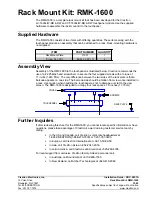
3
I56-6516-002
10/02/2018
WIRING AND MOUNTING
All wiring must be installed in compliance with the National Electric Code
and the local codes as well as the authority having jurisdiction. Wiring must
not be of such length or wire size which would cause the notification appli-
ance to operate outside of its published specifications. Improper connections
can prevent the system from alerting occupants in the event of an emergency.
Wire sizes up to 12 AWG (2.5 mm²) may be used with the mounting plate. The
mounting plate ships with the terminals set for 12 AWG wiring.
Make wire connections by stripping about
3
/
8
"of insulation from the end of
the wire. Then slide the bare end of the wire under the appropriate clamping
plate and tighten the clamping plate screw. We provide a wire strip guide. See
Figure 6 for wiring terminals and strip guide reference.
CAUTION
Factory finish should not be altered: Do not paint!
CAUTION
Do not over tighten mounting plate screws; this may cause mounting plate
to flex.
FIGURE 6. WIRING TERMINALS, SHORTING SPRING, AND STRIP GUIDE
Shorting Spring
Strip Guide
WIRING TERMINALS
1. Negative (-). Line in and out
2. Positive (+). Line in and out
3. Positive (+). Line in and out
4. Positive (+). Line in and out
5. Negative (-). Line in and out
A0527-01
FIGURE 7. 4-WIRE CIRCUIT
+
–
INPUT
FROM
FACP OR
PRIOR
STROBE
INPUT FROM
FACP OR PRIOR HORN
+
–
+
–
+
–
OUTPUT
TO NEXT
STROBE
OR EOL
OUTPUT TO NEXT
HORN OR EOL
A0366-01
SYSTEM WIRING
For 4-Wire installations, terminals 1, 2, and 3 connect to the strobe; terminals
4 and 5 connect to the horn. The horn and strobe circuits must be wired in-
dependently, and each circuit must be terminated with the appropriate EOL
device. Removal of a notification device will result in an open circuit indica-
tion on the strobe loop.
NOTE: A shorting spring is provided between terminals 2 and 3 of the mount-
ing plate to enable wiring checks after the system has been wired, but prior
to installation of the final product. This spring will automatically disengage
when the product is installed, to enable supervision of the final system. Only
available on indoor products (non K-series).
SHORTING SPRING FEATURE
System Sensor notification appliances come with a shorting spring that is pro-
vided between terminals 2 and 3 of the mounting plate to enable system con-
tinuity checks after the system has been wired, but prior to installation of the
final product. (See Figure 6.) This spring will automatically disengage when
the product is installed, to enable supervision of the final system.
MOUNTING AND REMOVING APPLIANCE
1. Attach mounting plate to junction box with the two screws provided. (See
Figure 8.)
2. Connect field wiring according to terminal designations. (See Figures 6 and 7.)
3. If the product is not to be installed at this point, use the protective dust
cover to prevent contamination of the wiring terminals on the mounting plate.
4. To attach product to mounting plate:
a. Remove the protective dust cover.
b. Hook the tabs on the top of the product housing into the grooves on mount-
ing plate.
c. Pivot the product into position to engage the terminals on the mounting
plate. Make sure that the tabs on the back of the product housing fully en-
gage with the mounting plate.
d. Hold product in place with one hand, and secure product by tightening the
single mounting screw in the front of the product housing.
Ceiling Models only:
To remove product from the mounting plate, loosen the
captive mounting screw and press the locking button.
FIGURE 8. CEILING MOUNTING
A0492-01
Locking
button
A0574-00
INSTALLING A SURFACE MOUNT BACK BOX
1. The ceiling surface mount back box may be secured directly to the wall
or ceiling. Use of grounding bracket with ground screw is optional. (See
Figure 9.)
2. The ceiling mount box can be used on ceiling horn strobes as well as ceil-
ing speaker and speaker strobe models. Use the STR cut-outs for ceiling horn
strobe installation needs. (See Figure 11.)
3. Threaded knockout holes are provided for the sides of the box for ¾ inch
and ½ inch conduit adapter. Knockout holes in the back of the box can be
used for ¾ inch and ½ inch rear entry.
4. To remove the ¾ inch knockout, place the blade of a flat-head screwdriver
along the outer edge and work your way around the knockout as you strike
the screwdriver. (See Figure 12.)
NOTE: Use caution not to strike the knockout near the top edge of the
surface mount back box.
5. V500 and V700 raceway knockouts are also provided. Use V500 for low
profile applications and V700 for high profile applications.
6. To remove the knockout, turn pliers up. (See Figure 12.)






















